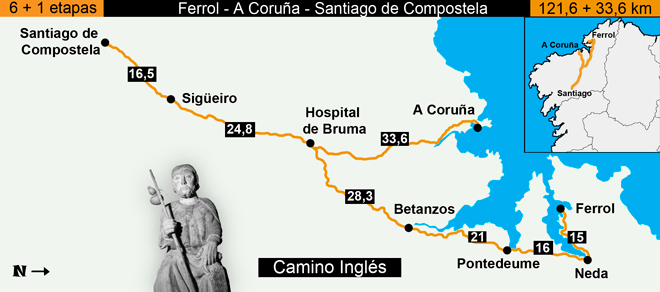The Camino Ingles is the shortest of the Caminos at 120km from Ferrol on the Coast (where ships of Pilgrims mainly from England, hence this Way's name, but also from Scandinavia would land).


Guidebooks:

The route heads essentially South around the Ferrol bay before heading to Pontedeume, Betanzos, Bruma and Segueiro passing through some beautiful countryside on the way - a lot of the eucalyptus forests that walkers of the Frances route from Sarria will be familiar with but this way is more difficult with longer stages (due to little choice with accommodation) and a lot of hills.
The starting point's Waymarker in Ferrol
It is also possible to start walking the Camino Ingles from A Coruna to Hospital de Bruma (a distance which of 30-40km - depending on who has measured this distance) where the two ways meet and from where it is 40km to Santiago. This makes a total distance of less than 100km which until recently made Pilgrims walking this route ineligible for the Compostela however as of December 2016 the Cathedral authorities in Santiago have indicated that they are prepared to issue a Compostela to pilgrims who can evidence a walk of at least 25 – 30km in the UK (or elsewhere) before to A Coruña.
'Considering the request of several Foreign Associations, Cofradías, the Galician Association of Friends of the Way of Santiago, as well as the Council of A Coruña and several institutions of Santiago, to grant Compostela to pilgrims departing from the herculine city on pilgrimage to Tomb of the glorious Apostle James, it is agreed, with the Vº B ° of the Archbishop, that this document can be issued to the following pilgrims:
- Given the historically documented tradition of the arrival of numerous pilgrims through the port of Corunna, the possibility of obtaining Compostela is granted to those who, having been part of the Way in their countries or regions of origin, make the distance on foot which separates the port of A Coruña from the Cathedral Compostelana.
-Also, the inhabitants of the city of A Coruña and its surroundings that, devotionis causa, visit the Jacobean spaces of their city, and make the rest of the pilgrimage on foot to the tomb of the Apostle Santiago.
-With regard to the pilgrims or walkers who do not meet these conditions, they may receive, however, the document accrediting to have visited the Cathedral and the tomb of the Apostle Santiago.'
The Confraternity of Saint James states that, '..at the moment only the Pilgrims Way (Winchester or London to Canterbury) or the Way of Saint Andrew (various starting points to St Andrews) have pilgrim passports and stamps which would provide proof for the Pilgrim Office in Santiago' (http://www.csj.org.uk/planning-your-pilgrimage/routes-to-santiago/routes-in-spain/the-camino-ingles/).
If anyone has done this then please let us know in the comments how easy it was to gain your Compostela.
(Information on the Pilgrims' Way can be found at http://footprintsonthecamino.blogspot.co.uk/2014/11/the-pilgrims-way.html, The Way of Saint Andrews has a website at http://www.thewayofstandrews.com/ )

Image from https://en.wikipedia.org/wiki/Tower_of_Hercules
Walking this route would give you the opportunity to see the Tower of Hercules a 55m tall Roman lighthouse built under Trajan (or possibly rebuilt in that period) and is the oldest Roman lighthouse still in use.
 Image from http://caminodesantiago.consumer.es/llevatela-al-camino/completa/?camino=camino-ingles - the elevations of other parts of both routes are also available
Image from http://caminodesantiago.consumer.es/llevatela-al-camino/completa/?camino=camino-ingles - the elevations of other parts of both routes are also available
Walking this route would give you the opportunity to see the Tower of Hercules a 55m tall Roman lighthouse built under Trajan (or possibly rebuilt in that period) and is the oldest Roman lighthouse still in use.
 Image from http://caminodesantiago.consumer.es/llevatela-al-camino/completa/?camino=camino-ingles - the elevations of other parts of both routes are also available
Image from http://caminodesantiago.consumer.es/llevatela-al-camino/completa/?camino=camino-ingles - the elevations of other parts of both routes are also availableGuidebooks:
- The CSJ has a guidebook on the Camino Ingles for £5 (see http://www.csj.org.uk/product/the-camino-ingles/) or the 2016 edition is available as a free download (although consider giving them a donation on their website) at http://www.csj.org.uk/wp-content/uploads/2016/07/CSJ-Camino-Ingles-Master-v.1-1.pdf
- Cicerone guides publish a book on the Northern Caminos which includes the Ingles for £16.95 (http://www.cicerone.co.uk/9781852847944.cfm#.VrSTVWfcuUk) - I used this guide and just scanned in the relevant pages before printing them out and taking them otherwise the book is rather heavy for only a few pages of information or you can just download the Ingles section of the guide for £3.56 (look on the 'buy individual routes' section of the page).
Whilst looking to see if anyone else produced a guidebook I came across this information on the American Pilgrims on the Camino's website (http://americanpilgrims.com/camino/route_descriptions/route_ingles.html):
'In December 1779, the leaking ship carrying John Adams and his companions to Paris was forced to put in at Ferrol from where they eventually made their way by land. Adams wrote about the Camino in his journal and he remarked there that he "…always regretted that We could not find time to make a Pilgrimage to Saint Iago de Compostella."'
|

Comments
Post a Comment